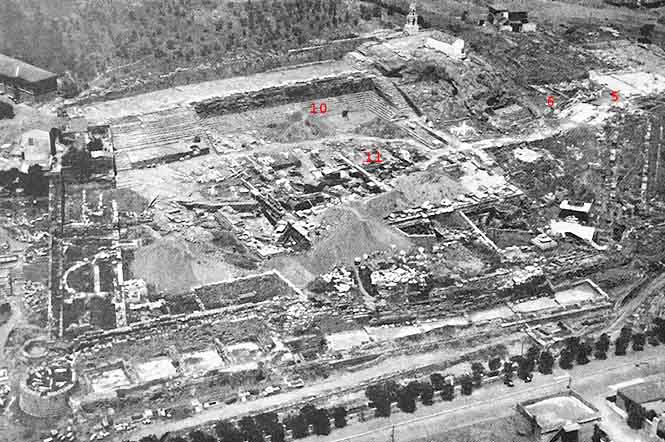
The numbers correspond to those on the map
Adapted from http://www.culture.gr
The Sanctuary of Eleusis

The Great Propylaia
The
settlement of Eleusis was founded in ca. 2000 B.C. on the slopes of
the hill, and during the Mycenaean period it developed into a large
fortified settlement, mostly due to its strategic position. During
this period the cult of Demeter was introduced, as the worship of a
deity connected to nature and the growing of cereals. The continuity
of Demeter's cult is attested until Roman times, by the erection of
successive temples on the east side of the hill.
In the 8th
century B.C. the sanctuary aquired a panhellenic character, and in
the time of Solon, the Eleusinian Mysteries were established as one
of the most important Athenian festivals. During the tyranny of
Peisitratos the sanctuary and the settlement were enclosed with a
massive fortification wall reinforced with towers. Splendid buildings
were erected during the Classical and Roman periods, but with the
spread of Christianity and especially after the invasion of the
Ostrogoths, the sanctuary was abandoned.
The most important monuments of the site are:
Sacred Court. It was the gathering place of the pilgrims and marked the end of the Sacred Way, which led to Eleusis from Athens. It contained the "Eschara", a structure dated to the 8th-2nd centuries B.C., with altars for the offerings to the goddesses, and the temple of Artemis Propylaea, dated to the 2nd century A.D.
Greater Propylaea. Doric propylon, a close copy of the central section of the Prolpylaea on the Athenian Acropolis, which were designed by Mnesikles. Dated to the second half of the 2nd century A.D.
Lesser Propylaea. Internal Ionic propylon, dedicated to the goddess by Appius Claudius Pulcher in 54 B.C.
The Telesterion. Large square hall with six entrances, two on each of the three sides, and eight tiers of seats along all of the four sides, where the initiates sat (only their foundations are preserved today). The centre of the hall was occupied by the "megaron", the adyton of the Eleusenian cult, where only the hierophantes (the high priest) was allowed to enter in order to perform the mysteric rites. Several architectural phases are distinguished in the building, dated from the 5th century B.C. until the 2nd century A.D. The Telesterion (5th century building) is by Iktinos the architect of the Parthenon and the Apollo Temple of Bassai.
Triumphal Arches. They are Roman reproductions of Hadrian's Arch in Athens, built after A.D. 129.
Callichoron Well. According to the Homeric Hymn, here rested Demeter, when she first came to Eleusis. Around this well the Eleusinian women performed dances during the ceremony in honor of the goddess. Dated to the first half of the 5th century B.C.
Ploutoneion. Sacred retaining wall around a cave where, according to tradition, Plouto, the god of the Underwolrd, appeared. A representation of the annual return of Persephone on earth took place here. Dated between the second half of the 6th and the 4th century B.C.
The Mycenaean Megaron. Part of foundations belonging to a rectangural temple with two columns on the longitudinal axis.
Aerial View of Eleusis
|
The numbers correspond to those on the map |
Plan of Eleusis
Models of the Sanctuary
|
The Propyleia |
The Telesterion |